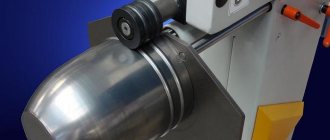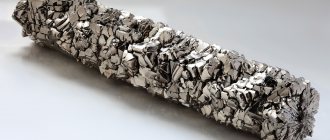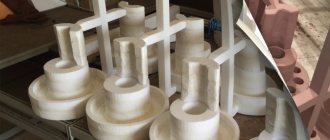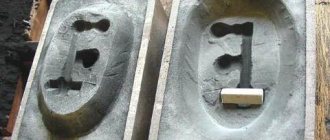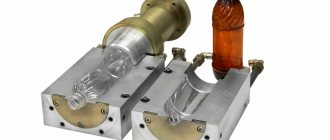Casting is a product obtained by pouring a liquid alloy into molds, in which, after cooling and solidifying, formation occurs. It can be a completely finished product or require further mechanical processing.
Divided into the following types:
- semi-finished products are ingots, which subsequently require a processing process;
- ingots processed under pressure;
- shaped castings – processed by cutting;
- finished products that do not require any mechanical processing are only cleaned or painted with decorative paint.
To produce castings, many types of metal and alloys, glass, plastic, wax and other starting materials are used. About 80% of blanks are obtained by sand casting, but the casting obtained in this way requires mandatory processing before being sent to the customer.
Foundry production makes it possible to obtain high-precision workpieces even with the most complex configuration, while gaps requiring processing are insignificant. The technology for producing castings is selected taking into account their size and production method.
There are three groups for producing castings:
1) in one-time forms;
2) according to soluble models;
3) casting in semi-permanent and combined type molds made of refractory materials:
These are the main types of casting, but in practice combined options are also used.
Metal casting
Metal casting is a production process based on the technology of pouring molten, hot metal into special molds, as a result of which cast blanks are obtained - castings. The cavity of the molds repeats the configuration of future workpieces and represents the working part of the casting mold, where the liquid metal enters. Here, future workpieces are cooled, hardened and given the appearance of the final product. Before delivery to the consumer, aluminum castings undergo mechanical processing (turning, milling, grinding and polishing).
This method is used to produce aluminum castings, which, due to their unique chemical properties, are used in many fields: in instrument making, construction, automotive, furniture production (fittings and decorative parts), etc. To obtain them, various technologies are used, the choice of which depends on sizes, configuration and other indicators required from the final product.
Sand casting
Sand casting is the most common and cheapest casting method. The initial stage of this method is the production of a casting model. Previously, it was made of wood, but in modern production plastic molds are made. The model is filled with a special mixture of sand and binder, which is compacted by pressing. Casting is carried out by pouring the melt into the formed cavities through special holes. After cooling, the mold is broken and removed, and then it must undergo processing.
In modern production, sand casting technology is carried out using vacuum molds that are filled with sand. To obtain the shape, a metal flask is used, which consists of two bottomless boxes, which are filled with sand and compacted. An imprint of the future model corresponding to the shape of the casting is taken on the surface of the connector. By connecting two molds, the melt is poured.
Basic methods of producing castings
⇐ PreviousPage 2 of 21Next ⇒The wide spread of foundry production is explained, firstly, by its relatively easy feasibility in technological terms, since it is only necessary to melt the metal and pour it into a suitably made working cavity of the casting mold, which was available to man even in prehistoric times.
The second circumstance is the ability to obtain solid products of a very complex configuration, of various sizes and weights. In this case, it is not necessary to assemble large products from individual parts, which is of great importance in mechanical engineering, as it allows one to obtain products of increased rigidity. For some products, the casting method is the only way to manufacture them, for example, sections of water heating radiators made of cast iron, cylinder blocks of internal combustion engines, etc.
The advantage of the casting method is the ability to produce products from alloys that cannot be fully processed by pressure, since they do not have the necessary ductility for this. Thanks to this, it is possible to use a huge amount of so-called cast alloys in mechanical engineering, for example, cast iron, bronze, many alloys of aluminum, magnesium, etc.
A characteristic feature of foundry production is also the following; in order to obtain a cast product, in the vast majority of cases, extensive production preparation, complex machines and high preliminary costs are not required. Therefore, foundry production is very maneuverable: it can be quickly and without high costs rebuilt from pouring one product to another; nothing prevents the production of extremely diverse products in one production; all foundry equipment is such that it performs its functions regardless of the outline of the casting, which is determined only by the configuration of the working cavity of the casting mold; Consequently, for this or that product it is only necessary to prepare such a cavity, and not to construct or modify the machine.
All this leads to the fact that the method of producing products by casting is cheaper than other methods.
Despite the significant differences in technological processes, in all cases it is characteristic that two properties of materials are used:
- mobility of the material in the initially liquid state, allowing it to easily take the configuration of the cavity into which the material is poured;
- the ability to harden while maintaining the shape given to it.
The quality of cast products is determined, firstly, by the material, and secondly, by the casting conditions of this material. The influence of casting conditions is so great that when they change, products from the same material can acquire different qualities.
The modern state of foundry production is characterized by complex mechanization and automation of technological operations, as well as the use of a variety of casting processes and materials that support them.
Currently, in industrialized countries, the following methods for producing castings are used for the production of castings:
- casting into disposable molds made from sand-clay mixtures;
- casting into one-time casting molds made using lost wax models;
- casting into one-time shell molds (cortical casting);
- casting into metal molds (chill casting);
-injection molding;
- centrifugal casting;
-semi-continuous casting, etc.
The most universal, flexible, simple and cheap way is casting into one-time molds from sand-clay mixtures. In industrialized countries, 60-65% of the total number of castings (by weight) are produced in this way. However, accuracy, surface finish and productivity in many cases do not meet the requirements of modern mechanical engineering. In this regard, in conditions of large-scale and mass production, special casting methods began to be used, which make it possible to obtain castings of increased accuracy, surface cleanliness and high productivity.
Meanwhile, special casting methods require the use of special equipment, devices and machines and relatively large preliminary costs. Therefore, it is economically feasible to use them only in conditions of large-scale and mass production.
⇐ Previous2Next ⇒
Site search:
Chill casting
This is the highest quality method of casting, which is carried out using a collapsible metal mold. After hardening, the chill mold is reused. But this is done after it is cleaned. The peculiarity of this method is that the solidification of the liquid melt occurs without any external influence. The products obtained in this way have a fine-grained, dense structure, ensuring tightness and good mechanical properties.
Chills are used to produce castings from various alloys, most often aluminum and magnesium, which have a low melting point. In this case, one mold can be used up to 1000 times. Chill casting is a very effective method for mass production of parts, which is the reason for its use in up to 45% of products.
Continuous casting
A process that allows metals and alloys to stretch, shape, and harden without having to interrupt the pour. At the same time, waste is reduced, the yield of finished products is increased, and the economic efficiency of production is improved.
Battery grids are manufactured using continuous injection molding. Using a water-cooled roller and mold system reduces the chance of impurities and provides a better thickness ratio.
Injection molding
This method guarantees a high quality surface, which then does not have to be machined. It is very productive for producing parts of various configurations, weighing from several grams to tens of kg.
Injection molding allows you to produce complex parts with curved surfaces and various channels. In this case, zinc, magnesium, brass and aluminum castings are most often used.
LPD technology has many advantages:
- low price;
- casting accuracy in size and configuration;
- Many castings are produced from one mold.
But this technology also has a number of disadvantages: the duration of the process, the high cost of producing molds, difficulties in obtaining castings containing hidden cavities, as well as the possibility of gas holes and shrinkage cracks appearing in the workpieces.
For the production of aluminum castings in LPDs, special equipment is used, equipped with a cold horizontal chamber designed for pressing the material, and semi-automatic machines for casting zinc alloys with a hot chamber for pressing the material and with a locking force.
Under regulated pressure
A type of injection molding that provides better process control. There are many factors that can affect the quality of the final product. The following variables play an important role in the controlled injection molding process:
- The rate at which molten metal is introduced into the mold cavity. It is important that the molten metal completely fills the cavity before it begins to solidify. If the metal flow rate is not ideal, it will negatively impact the strength of the final product.
- Injection pressure, which directly affects the rate at which molten metal enters the mold cavity. In controlled injection molding, the injection pressure is increased to improve sealing. A combination of high injection pressure and larger gate sizes is used to ensure structural stability of the casting. This in turn improves the overall mechanical properties of the casting, particularly the tensile strength.
- The time required for the molten metal to fill the cavity depends on the speed of the metal at the gate and the area of the gate. If the gate is large, the injection speed can be low, but if the gate is small, the injection speed must be high in order to completely fill the cavity.
For injection molding, alloys of metals and alloys are used, which are characterized by increased casting properties (fluidity).
An important factor affecting the castability of an alloy is the solidification interval. If the difference between the solid and liquid point of the alloy is large, controlled pressure casting is not used.
Lost wax casting
This method allows for high-precision casting. An exact copy of the model is made in advance from paraffin, wax and stearin and other materials, as well as a gating system. It is used in cases of manufacturing high-precision parts (for example, turbine blades, etc.).
A suspension is applied to the model block and sprinkled with a refractory filler made of quartz, distensilimanite, electrocorundum, etc. It is necessary to apply 6 - 10 layers, each of them dries for about half an hour. This process is accelerated by drying ovens pumped with ammonia gas. Thus, a shell is formed from which the model composition is melted. This is done in water, by exposure to high pressure steam or by burning.
The next stage of investment casting is calcination of the block by heating at a temperature of 1000 degrees Celsius. Then the heated block is placed in the furnace and molten metal is poured into the shell. The last stage is cooling, knocking out and cutting the casting. The advantage of this method is the casting of castings from alloys that are difficult to machine. This technology is used both for the production of single parts and in mass production.
ESSENCE OF CASTING TECHNOLOGICAL PROCESSES
Modern foundry technologies make it possible to produce products with high performance properties. Castings work reliably in jet engines, nuclear power plants and other critical machines. They are used in the manufacture of building structures, machine tools and pressing equipment, marine vessels, and parts of household equipment.
Under the casting method
understand the process of obtaining workpieces by pouring molten metal of a given chemical composition into a casting mold, the cavity of which has the configuration of the workpiece.
In modern foundry production, two main methods are most often used:
· sand casting,
· special casting methods.
Sand casting
is the most common method of making castings. This method produces castings from cast iron, steel, and non-ferrous metals in a wide range of weights and sizes. The essence of this process is to produce castings from molten metal, solidified in molds that are made from molding sands by compaction using a pattern kit.
The stages of the technological process for making castings in sand molds are presented in Figure 17.1.
Rice. 17.1. Stages of the technological process for manufacturing castings in sand-clay molds
Below the casting model
(Fig. 17.2) understand the device with which an imprint is obtained in the casting mold corresponding to the configuration and dimensions of the casting.
Detachable and one-piece models, wooden, metal and plastic are used. In Figure 17.2, b
shows a model for casting in a sand-clay mold made by the most modern method - prototyping.
Rice. 17.2. Part obtained by casting into a sand-clay mold (a)
and its casting model
(b)
Under the core box
(Fig. 17.3) understand a form-building product that has a working cavity for obtaining a casting core of the required size and shape from the core mixture. Casting cores are installed to form: cavities, holes, and other complex contours of the workpiece.
Rice. 17.3. Core box: 1,2
- half-forms of a box,
3
- fragment of a flask,
4
- finished rod,
5
- types of rods in mechanical engineering
Natural and artificial materials are used to prepare mixtures
. Usually quartz or zircon sand and binding additives are used. Additives provide strength, plasticity and thermal stability of the molding sand.
Preparation of molding sand
includes several operations: mixing the mixture components, moistening and loosening.
The production of foundry molds is similar in its physical essence to the construction of holes by a child in a sandbox. The child places one hand on the sand, pours it on top and compacts it with the other hand. After compacting the sand, the child pulls his hand out of it and there remains a “mink”, which in size and shape resembles his hand covered with sand.
In real casting technology, instead of a child’s hand, a model of the product that will be cast is used. A casting mold usually consists of an upper and lower mold halves, which are made in flasks. The basic operations for making casting molds are shown in Figure 17.4.
Rice. 17.4. Basic operations for making molds
The mold is assembled and filled with molten metal. Filling is carried out from teapot, drum and other types of ladles. The mold is filled with molten metal through a gating system. The gating system is understood as a set of channels and reservoirs through which the melt flows from the pouring ladle into the mold cavity.
The cooling process of castings lasts from several minutes (for small thin-walled castings) to several days and weeks (for large thick-walled castings). To reduce the cooling time, forced cooling methods with water or air are used.
Casting knockout
- This is the process of removing a casting that has hardened and cooled to a certain temperature from a casting mold, during which the casting mold is destroyed. Carry out on special knockout installations.
Cutting off castings
- this is the process of removing profits, sprues, projections and fills from the casting at the junction of the mold halves. After cutting, the castings are cleaned.
Casting cleaning
– this is the process of removing burnt marks, residues of molding and core mixtures from the external and internal surfaces of castings. It is carried out in tumbling drums, in hydrosandblasting and shot blasting chambers, as well as by chemical or electrochemical processing.
Despite its versatility and relative cheapness, the sand casting process is associated with a large flow of auxiliary materials and high labor intensity. 15-20% of the workpiece mass turns into chips during subsequent machining.
The transition to special casting methods makes it possible to reduce machining allowances and the amount of chips to 5-7%.
Special casting methods allow:
· obtain castings of increased accuracy and with higher surface cleanliness,
· reduce costs for molding sand materials.
In modern engineering production, there are more than 50 special casting methods, which differ from sand casting in the following ways:
- design of casting molds,
- material of casting molds,
- using external influences to fill out forms, etc.
The most common special casting methods are shown in Figure 17.5.
Rice. 17.5. Special casting methods
· INJECTION MOLDING
- this is a casting process when the molten material is fed into the casting mold under sufficiently high pressure, which can significantly reduce the risk of receiving defects in the form of shells and porosity (Fig. 17.6).
First, the metal is delivered to the pressing chamber (Fig. 17.6, a
), then fed into the cavity of the mold (Fig. 17.6,
b
).
After the casting has solidified, the mold opens, the core is removed, and the casting is removed from the working cavity of the mold (Fig. 17.8, c
).
Fig. 17.6. Diagram of the injection molding process: metal pouring ( a
), pressing (
b
), extraction of the workpiece (
c
), workpieces obtained by this method (
d
);
1
- pressure piston,
2
- mold parts,
3
- supporting elements,
4
- mold cavity,
5
- ejector
LOST WASTE CASTING
- this is a process when models are made in molds from a low-melting material (wax or stearin) (Fig. 17.7,
a
), which are alternately immersed in an adhesive composition and in “boiling” sand, thereby increasing a layer of glued sand on the surfaces of the models. Then all this is placed in an oven or boiling water, where the low-melting material of the models melts and flows out of the molds and they are placed in the oven for calcination.
Rice. 17.7. Process process using lost wax models: wax model ( a
), shell mold (
b
), pouring process (
c
), blanks obtained by this method (
d
)
The result is a strong but fragile shell (Fig. 17.7, b
), into which the molten material is poured (Fig. 17.7,
c
), and after the casting has solidified, the mold is easily destroyed by a small dynamic load, for example, from a blow with a hammer or from slight pressure with a press.
SHELL CASTING
The technology of the manufacturing process for casting molds is the same as for lost wax models, but the models themselves are made in the same way as for sand casting. This makes it possible to make casting molds using simple and cheap technology and obtain large-sized castings, but the productivity of the process is significantly lower than with lost wax casting.
MOLD CASTING
is a process of casting into a reusable metal mold, which provides a fairly high productivity of the process, but requires much higher costs for its production.
CENTRIFUGAL CASTING
- this is a process when the casting mold must rotate while feeding molten material into it, which, under the influence of centrifugal forces, is pressed against the walls of the mold (Fig. 17.8).
Rice. 17.8. Scheme of the vertical centrifugal casting process ( a
), blanks obtained by this method (
b
);
1
- motor for rotation,
2
- mold,
3
- molten metal,
4
- ladle
Centrifugal forces help compact the casting material, reducing the risk of defects in the form of porosity and cavities. This technology makes it possible to produce multilayer castings from various materials.
During continuous casting, molten metal from a metal receiver passes through a graphite nozzle into a water-cooled crystallizer and solidifies in the form of a casting, which is drawn out by a special device.
To produce castings using special casting methods, the following are most often used:
· gray, high-strength and malleable cast irons;
· carbon and alloy steels;
· copper (bronze and brass), zinc, aluminum and magnesium alloys;
· alloys of refractory metals (titanium, molybdenum, tungsten).
The advantages of special casting methods are:
· production of workpieces with high weight accuracy (for special casting methods);
· production of castings of practically unlimited dimensions and weight;
· obtaining workpieces from alloys that are resistant to plastic deformation and difficult to machine by cutting (magnets).
You will become more familiar with some casting processes in laboratory work.
| | | next lecture ==> | |
| Physiological basis of machine milking | | | Moment of power. Moment of impulse. |
Date added: 2017-03-12; views: 5679; ORDER A WORK WRITING
Find out more:
Casting using gasified models
LGM technology is the most profitable solution in terms of efficiency, environmental friendliness and high quality of the resulting shaped castings. This method is increasingly being introduced in global production, and it is especially popular in the USA and China. First, a copy of the model is made from foam plastic, which is placed in a sand mold. In this way, castings weighing up to 2 tons or more, with sizes ranging from 40 to 1000 mm, are produced.
This method is actively used in engine building to produce cylinder heads, individual blocks and other parts. At the same time, for a suitable casting weighing 100 kg, several types of non-metallic materials are consumed, intended for the formation of mold models:
- Non-stick coating – up to 25 kg;
- Quartz sand – 50kg;
- Expanded polystyrene – 6kg;
- Polyethylene film - about 10 sq.m.
In this case, molding consists of filling the model with a sand composition, with the possibility of its reuse in 95-97% of cases.
Centrifugal casting
Centrifugal casting is used to produce parts with the shape of a rotating body made of cast iron, aluminum, steel and bronze. The melt is poured into a metal mold, which rotates at speeds of up to 3000 rpm.
Due to centrifugal force, the melt is evenly distributed inside the mold, and after crystallization, a casting is formed. This method makes it possible to obtain two-layer workpieces consisting of various alloys. The casting obtained in this way has a high density and good physical and mechanical properties.
The big advantage of centrifugal casting is the possibility of forming internal cavities without the need to use rods, as well as saving alloy due to the absence of a gating system. This method produces up to 95% of suitable products.
The production process uses equipment equipped with horizontal axes of rotation. The centrifugal casting method is widely used to produce castings of sleeves, bushings and other parts with the shape of a rotating body.
Shell casting
The shell mold casting method makes it possible to obtain shaped aluminum castings from metal alloys by filling them with a mixture of sand grains (mainly quartz) and synthetic powder (pulver-bakelite and phenol-formaldehyde resin).
The shell form is obtained by pouring it onto a metal model heated to 300 °C and holding it until a hardened thin layer is formed. After this, the excess mixture is removed. If a clad mixture is used, it is blown into the gap formed between the outer contour plate and the heated model.
In both the first and second cases, it is necessary to wait for the shell to harden on the model in the oven. The next stage is the fastening of the resulting half-forms, their placement in a metal case and pouring of the melt. This method is used to cast aluminum castings weighing up to 25 kg. The advantages of this technique are control over the thermal cooling conditions of workpieces, the possibility of mechanizing the process and increasing productivity.

